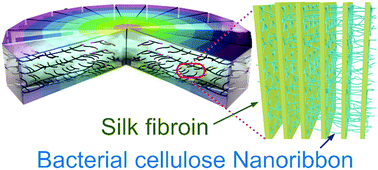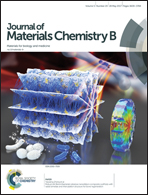Robust silk fibroin/bacterial cellulose nanoribbon composite scaffolds with radial lamellae and intercalation structure for bone regeneration†
Abstract
A big challenge in bone regeneration is preparation of an appropriate bone extracellular matrix that mimics the robust mechanical properties of the lamellar structure of natural bones as well as the in vivo micro-environment of bone cells. In this work, silk fibroin (SF)/bacterial cellulose nanoribbon (BCNR) composite scaffolds were prepared using various BCNR contents via a multi-staged freeze-drying method. The scaffolds showed a radial lamellar pattern and gradient lamellae gap distance, the structure of which could transfer nutrient solution and metabolic waste through a capillary effect, and can guide cells from the outer to the inner area of the scaffolds. The gap distance and thickness of the lamellae increased with increasing BCNRs contents. Parts of BCNRs attached to the surfaces of lamellae while others penetrated into it. The intercalation structure led to an eight-fold enhancement in compression modulus and six-fold increase in compression strength. These robust three-dimensional composite scaffolds with improved in vitro bioactivity, bone-cell adhesion, and proliferation are highly promising for further applications in bone defect repairs.



 Please wait while we load your content...
Please wait while we load your content...